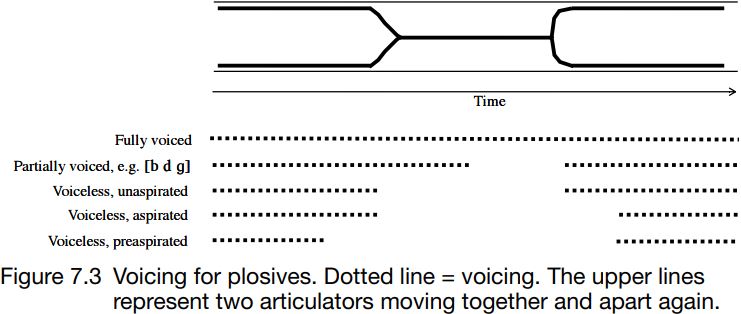


 Grammar
Grammar
 Tenses
Tenses
 Present
Present
 Past
Past
 Future
Future
 Parts Of Speech
Parts Of Speech
 Nouns
Nouns
 Verbs
Verbs
 Adverbs
Adverbs
 Adjectives
Adjectives
 Pronouns
Pronouns
 Pre Position
Pre Position
 Preposition by function
Preposition by function 
 Preposition by construction
Preposition by construction
 Conjunctions
Conjunctions
 Interjections
Interjections
 Grammar Rules
Grammar Rules
 Linguistics
Linguistics
 Semantics
Semantics
 Pragmatics
Pragmatics
 Reading Comprehension
Reading Comprehension|
Read More
Date: 2023-07-11
Date: 2023-08-03
Date: 2023-12-14
|
English phonology recognizes two sets of plosives, ‘voiced’ /b d g/ and ‘voiceless’ /p t k/, as in pairs such as ‘pit’ – ‘bit’, ‘rapid’ – ‘rabid’, ‘locking’ – ‘logging’, ‘hat’ – ‘had’. These labels are not so helpful from a phonetic perspective, because they hide the complexity of the relationship between voicing, closure and release.
Vowels before [p t k] are regularly shorter than vowels before [b d g]: compare the vowels of ‘lock’ and ‘log’ (e.g.  ) or ‘heat’ and ‘heed’ (
) or ‘heat’ and ‘heed’ ( ).
).
There are many permutations of voicing and closure. There can be voicing throughout the hold phase, within constraints. Voicing can stop before, at or after the closure is achieved; and start again at or after release. Some possible arrangements are illustrated in Figure 7.3.
The time between the release and the onset of voicing is called voice onset time (VOT). It is measured in milliseconds (ms). If the voicing starts after release, VOT is said to be positive, while if it starts before release, it is said to be negative.

|
|
|
|
4 أسباب تجعلك تضيف الزنجبيل إلى طعامك.. تعرف عليها
|
|
|
|
|
|
|
أكبر محطة للطاقة الكهرومائية في بريطانيا تستعد للانطلاق
|
|
|
|
|
|
|
أصواتٌ قرآنية واعدة .. أكثر من 80 برعماً يشارك في المحفل القرآني الرمضاني بالصحن الحيدري الشريف
|
|
|